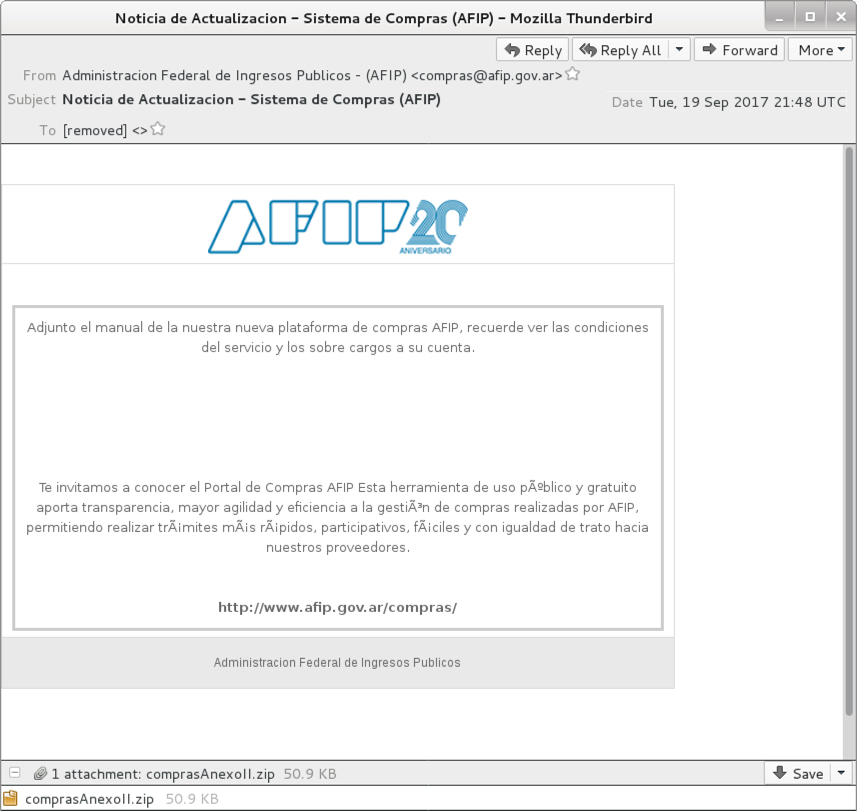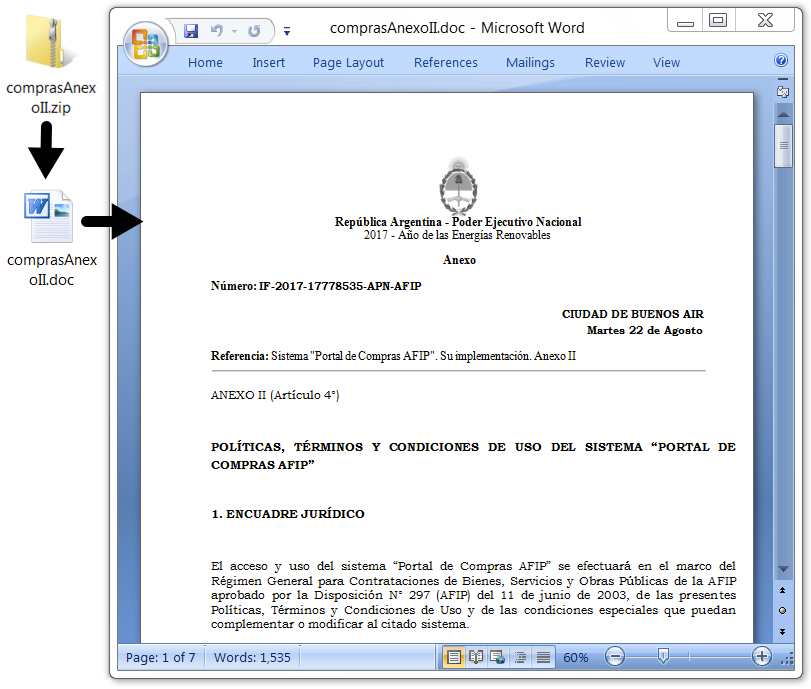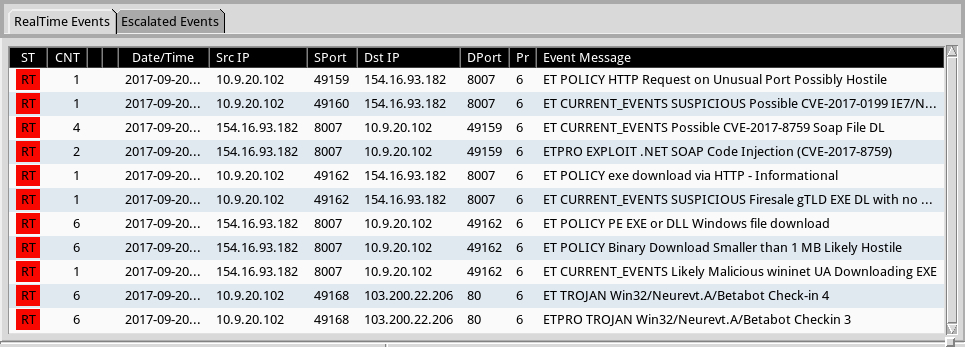Email attachment using CVE-2017-8759 exploit targets Argentina
Introduction
On 2017-09-12, FireEye published a blog post about a zero-day exploit utilizing CVE-2017-8759. The vulnerability was fixed that same day with Microsoft's September 2017 Security Updates.
In FireEye's blog post, this exploit was used against Russian speakers to distribute FINSPY malware. By 2017-09-19, I ran across another email spoofing an Argentina government agency using a CVE-2017-8759 exploit to distribute Betabot malware.
Today's diary reviews the email, malware, and traffic associated with this most recent exploit for CVE-2017-8759.
The email and attachment
The email pretends to be from the Administracion Federal de Ingresos Publicos (AFIP) a Argentina government agency responsible for tax collection and administration. The message actually came from a commercial mail server on an IP address assigned to Gualberto Larrauri, an Argentina-based Internet service provider (ISP).
The message describes the attachment as a manual for the AFIP purchasing portal. The attachment is a zip archive, and that archive contains a Rich Text Format (RTF) file with .doc as the file extension. True to its word, the RTF file contains an annex to the official AFIP document covering the subject. It also contains an exploit for CVE-2017-8759. Merely opening the file using Microsoft Word will infect a vulnerable Windows computer.

Shown above: Screenshot of the email.

Shown above: Email headers indicate where the email actually came from.

Shown above: The email attachment and extracted RTF document.
Follow-up malware
Opening the RTF document generated Powershell activity that retrieved a Windows executable. This follow-up executable triggered EmergingThreats alerts for Neurevt.A/Betabot when I infected a host in my lab. The malware was made persistent through a Windows registry update.

Shown above: Follow-up malware (Betabot) made persistent on the infected Windows host.
Network traffic
Infection traffic included HTTP requests for SOAP code injection, JavaScript, Powershell script, and a Windows executable over TCP port 8007. Post-infection activity consisted of HTTP POST requests over TCP port 80.

Shown above: Network traffic for this infection filtered in Wireshark.

Shown above: Alerts from Sguil in Security Onion using Suricata with the EmergingThreats Pro ruleset.
Indicators of Compromise (IOCs)
Headers from the email:
- Received: from vtcc.com.ar ([186.121.171.235])
- Envelope-sender: <compras@afip.gov.ar>
- Message-ID: <f651ef3fdcbc53e64929aca0ff1df14d@vtcc.com.ar>
- Date: Tuesday, 2017-09-19 at 21:48 UTC
- From: "Administracion Federal de Ingresos Publicos - (AFIP)" <compras@afip.gov.ar>
- Subject: Noticia de Actualizacion - Sistema de Compras (AFIP)
File hashes:
SHA256 hash: 7bd46284dabf1f400102aa35e123eb2ffe2838560fbc016ba4f2cd376742004c
- File size: 52,132 bytes
- File type: Zip archive
- File name: comprasAnexoII.zip
- File description: Email attachment
SHA256 hash: 4a07c6f26ac9feadbd78624d4e063dfed54e972772e5ee34c481bdb86c975166
- File size: 286,981 bytes
- File type: Rich Text Format (RTF) file
- File name: comprasAnexoII.doc
- File description: RTF file with CVE-2017-8759 exploit
SHA256 hash: 610e6611b3b2e3bd85173cba76bf069fb7134b86f533141f79811fcc29d62b33
- File size: 440,832
- File type: PE32 executable
- File location: hxxp://classupdate.punkdns.top:8007/txt/words.exe
- File location: C:\ProgramData\SystemMicrosoftDefender2.1\[random characters].exe
- File description: Follow-up malware, Neurevt.A (Betabot)
Infection traffic:
- 154.16.93.182 port 8007 - classupdate.punkdns.top:8007 - GET /txt/doc.txt
- 154.16.93.182 port 8007 - classupdate.punkdns.top:8007 - GET /txt/accounts.hta
- 154.16.93.182 port 8007 - classupdate.punkdns.top:8007 - GET /txt/pause.ps1
- 154.16.93.182 port 8007 - classupdate.punkdns.top:8007 - GET /txt/words.exe
Post-infection traffic:
- 103.200.22.206 port 80 - av.bitdefenderesupdate.ru - POST /.av/logout.php
- 103.200.22.206 port 80 - av.bitdefenderesupdate.ru - POST /.av/logout.php?id=[various numbers]
Final words
As I write this, nine days have passed since Microsoft released its update to address CVE-2017-8759. The associated exploit is no longer a zero-day. If your organization follows best security practices, you should be fine.
However, many organizations are notoriously slow to apply these updates. Be aware this exploit is active in the wild. I'm sure it will eventually find its way to wide-scale distribution through malicious spam.
A copy of the email, taffic, and associated malware for today's diary can be found here.
---
Brad Duncan
brad [at] malware-traffic-analysis.net


Comments
What about Protected view? Does it escape it?
Anonymous
Sep 21st 2017
8 years ago
That's a good question! The original FireEye article doesn't discuss it.
Word 2010 has Protected View enabled enabled by default, and it triggered the infection traffic. Microsoft's article states you should have Protected View mode disabled, but it doesn't state which version of Word it used. https://blogs.technet.microsoft.com/mmpc/2017/09/12/exploit-for-cve-2017-8759-detected-and-neutralized/
I just tried it using Word 2016 with default settings (Protected View enabled), and I saw the same attempts by my test host to connect with classupdate.punkdns.top over TCP port 8007. However, the server at classupdate.punkdns.top appears to have been taken off-line, so I can no longer replicate the infection traffic. My guess is the CVE-2017-8759 exploit actually -does- work with Protected View enabled in Word 2016, as long as the September 2017 update hasn't been installed.
Keep in mind that CVE-2017-8759 is a vulnerability for Microsoft's .NET Framework, so I don't think this vulnerability is due to a specific issue with Microsoft Word or Microsoft Office. http://www.cve.mitre.org/cgi-bin/cvename.cgi?name=CVE-2017-8759
Anonymous
Sep 21st 2017
8 years ago
All such exploits, 0days included, which try to execute arbitrary scripts or executables are simply neutered if you follow best security practice: use Software Restriction Policies alias SAFER/AppLocker to deny execution everywhere unprivileged users can write.
Additionally consider the add an NTFS ACE which denies execution to "everyone" at least for %TEMP%, %ProgramData%, %USERPROFILE%\Downloads, %APPDATA%, %LOCALAPPDATA% etc.
Anonymous
Sep 21st 2017
8 years ago